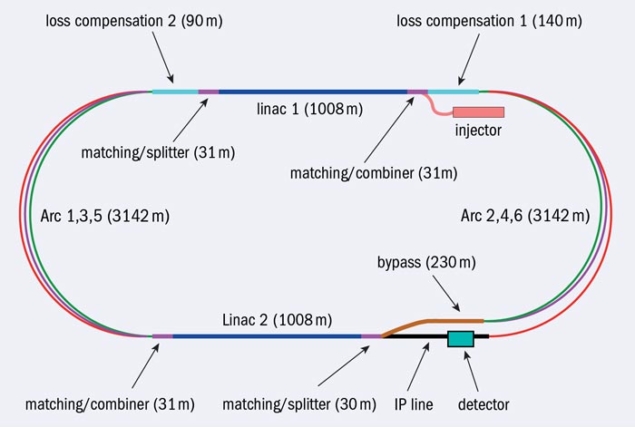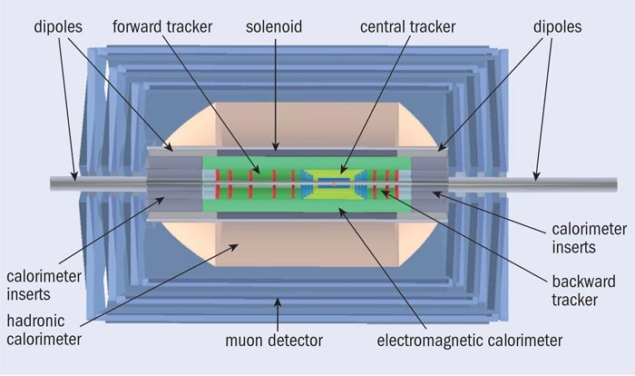In the LHeC, an electron beam would collide with the hadron beams of the LHC to allow a rich programme of physics.

This month sees the final touches being made to a detailed, 500-page report on the physics programme, a detector design and the accelerator options for the proposed Large Hadron Electron Collider (LHeC) project. Following invitations by CERN and the European Committee for Future Accelerators (ECFA) and after three annual workshops, a study group of nearly 200 physicists and engineers from 60 institutes has now laid out the motivation and design concepts for a next-generation collider and a detector to explore the tera-electron-volt energy scale. The technical and particle physics aspects of the report have been refereed by more than 20 world experts, who were invited by CERN last year to scrutinize the design. The design process was monitored by ECFA and the Nuclear Physics European collaboration Committee (NuPECC), as well as by a scientific advisory committee. The potential for electron–ion scattering led NuPECC in 2010 to include the LHeC in its long-range plan for European nuclear physics.
The LHeC project involves extending the capabilities of the LHC with a 60 GeV polarized electron beam, which in collisions with the intense proton (and ion) beams of the LHC would reach luminosities about 100 times larger than at HERA, the world’s first electron–proton collider that ran at DESY in the years 1991–2007. The aim would be to exceed HERA’s maximum four-momentum-transfer squared, Q2, by a factor of 20. This would open up a new chapter in the physics of deep inelastic-scattering (DIS), a story that began at SLAC with the discovery of quarks as the smallest constituents of the proton in 1968. More recently it led to the discovery at HERA that at small relative parton momenta, x, the proton is largely determined by gluon interactions, which also give mass to the visible matter of the universe.
The electron beam for the LHeC could be supplied by a new electron storage-ring mounted on top of the LHC, for which new, lighter, high-quality dipole magnets have been successfully developed both at CERN and at the Budker Institute of Nuclear Physics, Novosibirsk, in accordance with the design report. An alternative is to use an electron linac in a “racetrack” configuration of 1/3 the circumference of the LHC. This would consist of some 120 accelerating-cavity cryomodules placed in two linacs, each 1 km long and connected by triple return arcs (figure 1). These superconducting cavities operate in a continuous-wave mode at a gradient of about 20 MV/m, similar to the European XFEL project at DESY, and at a frequency that is likely to be 721 MHz. The limitation of the total power consumption to 100 MW and the necessity to achieve maximum luminosity, in excess of 1033 cm–2 s–1, led to the linac for the LHeC being designed as an energy-recovery linac. The concept of energy recovery is growing in popularity and with the LHeC, CERN and its partners would develop the highest-energy application. With a linac length of 2 km, the new accelerator is no longer than SLAC’s famous linac; however, the reach in Q2 is enlarged by a factor of almost 105 owing to the collider configuration and the high-energy beams of the LHC.

The design report describes the machine physics, such as optics and beam–beam dynamics, for both options for the LHeC’s electron beam, as well as schemes to achieve high positron currents in the linac option. It also gives details for the various elements of the accelerator system, such as the warm dipole and cold interaction-region magnets, the cryogenics and the power supply (RF) components.
To achieve the high integrated luminosity at the LHeC, the design envisages that the LHC would operate synchronously with electron–proton and proton–proton collisions. This would turn the LHC into a novel three-beam facility; it also determines the time schedule for building and operating the LHeC (figure 2).

The report also covers a new collider detector, designed for high acceptance – down to 1° to the beam axis – and for the highest precision. Relying on novel technologies, as used in the ATLAS and CMS experiments and being developed for their upgrades, and based on the experience from the H1 and ZEUS detectors at HERA, the detector could be built in the 10 years or so available. Figure 3 shows the main detector, which is complemented by forward devices to tag protons, neutrons and deuterons for diffractive-scattering studies, and by backward electron and photon calorimeters for tagging events at low Q2 (photo-production) and for measuring the luminosity with Bethe-Heitler scattering. With the assumption of only one interaction region being available for the LHeC in the 2020s, the report considers only one collider detector, with possibly two analysis collaborations to ensure independent and competing analysis approaches – a novel concept for particle physics
The design report will provide valuable input to the discussion on the future of European particle physics. The next steps towards the LHeC will be discussed at a workshop near Coppet, near Geneva, on 14–15 June. The project offers the promise for a new multipurpose experiment for particle physics at CERN. It is reminiscent of the time when the SppS operated while CERN was also the centre of DIS with its muon- and neutrino-scattering experiments such as BCDMS and CDHSW. The LHeC builds on the LHC, enriching its physics harvest substantially and continuing the tradition of DIS as part of the exploration of the energy frontier. The accelerator technology and the experimental prospects are fascinating. By increasing the energy or the positron intensity there is also a bright future for further developments, reaching into the time when the LHC could be replaced by a new high-energy proton–proton collider and where the maximum Q2 could approach 10 TeV2.
LHeC points of view
The physics chapters of the design report discuss the rich and unique programme of the LHeC. There exist different and complementary points of view on the interest in such a project:
• The LHC point of view sees the LHC as the natural, highest-energy collider for finding physics beyond or complementing the Standard Model. New particles observed in proton–proton collisions may also be produced in electron–proton interactions and their characteristics studied. One example would be the Standard Model scalar boson at 125 GeV, if confirmed; its charge-parity properties and decays to b-quark pairs may be cleanly investigated at the LHeC in the process of WW fusion. If new particles or phenomena are so heavy that they can be seen only at the LHC, the precise understanding of quarks and gluons, mostly at large Bjorken x, could become crucial in distinguishing new observations from instrumental or merely partonic effects.
• The precision-physics point of view recognizes the unique potential related to ultraprecise electron–proton measurements. A far-reaching programme of investigations in experimental DIS physics and in perturbative QCD is linked to the possibility of measuring the strong coupling constant αs(MZ2) with tenfold improved precision (to per mille accuracy) as required in supersymmetric grand-unification scenarios of the electromagnetic, weak and strong interactions.
• The parton-distribution function (PDF) point of view emphasizes that the LHeC, for the first time, provides a complete foundation based not on fits but on data for the determination of the distributions of the two valence and six sea quarks, including the first mapping of those for the strange and top quarks. The LHeC maps the gluon distribution to unprecedented precision in a range from very low x > 10–6 to x close to 1. The complete set of precision PDFs is crucial for extending the ranges of searches at the LHC or for measuring the mass of the W boson.
• From a QCD point of view, this precision needs to be matched by calculations of a further order of perturbation theory. New theoretical concepts, such as generalized parton distributions (based on scattering amplitudes), unintegrated parton distributions (that take transverse parton momenta into account) and diffractive parton distributions, are in their infancy. Factorization and resummation may be tested decisively in combining data from the LHC and LHeC. The investigation of high-energy electron–proton scattering can also be important for constructing a non-perturbative approach to QCD based on effective string theory in higher dimensions.
• From a neutron point of view, tagging the spectator proton in electron–deuteron collisions leads to a removal of the corrections for Fermi motion. Moreover, the nuclear-shadowing effects may be controlled with diffractive scattering as proposed by Vladimir Gribov. These new methods would put tests of neutron structure, parton-symmetry relations and the evolution of QCD on new, firm ground.
• The heavy-ion point of view notes that the LHeC will extend the kinematic range in electron–ion scattering by almost four orders of magnitude and lead to essential innovations in understanding nuclear parton distributions. This is deeply related to the initial state of the quark–gluon plasma and will allow the black-body limit of deep inelastic electron–ion scattering to be established experimentally. Such a possibility would complete the exciting programme of physics with heavy ions at the LHC.
• From the HERA point of view, there is a large programme to be performed with higher luminosity. Examples include precision measurements of the longitudinal structure function down to low x, or the solution of the up-to-down quark limit at high x, with data free of both nuclear and power corrections.
• The photon point of view recognizes that the most elementary boson yet has a quantum mechanical, partonic (gluon, charm etc.) structure, which could be uniquely investigated at the LHeC. It will allow both new phenomena and classic QCD subjects in photoproduction to be studied at much higher energy. The LHeC design with a linear accelerator could also generate a real photon beam, allowing the possibility of the first-ever photon–proton collider.
• The surprise point of view, finally, relies on the greatly extended kinematic range and high luminosity for observing fundamentally new phenomena. HERA discovered the marked rise of parton densities towards low x and that in 10% of the events the proton remained intact despite the violence of the interaction – a fact that remains surprising. Known candidates for discovery are: a three-gluon state, the odderon; a topological QCD phenomenon, the instanton; a currently hypothetical substructure of the top quark or weak bosons; and the exclusion of the saturation phenomenon. Top quarks have never been noticeably produced in deep inelastic-scattering but they will appear copiously at the LHeC. Steps into an unknown kinematic region have always led to surprises, either through new particles or through their absence.








